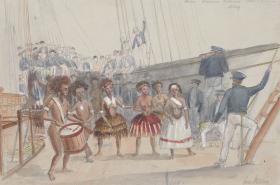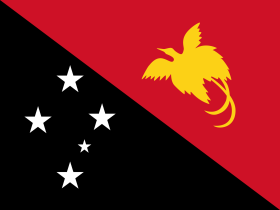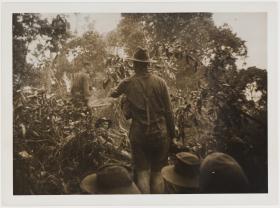A diverse and connected world: Papua New Guinea
Key inquiry question #1
How do people’s connections to places affect their perception of them?
Content summary
Students:
- investigate how connections influence people’s perception and understanding of places, for example: (ACHGK036)
- identification of factors that influence people’s perceptions of places eg media, culture, education, travel
- discussion of the effect of generalisations and stereotypes about places
Background notes for teachers:
Natural features of Papua New Guinea
Much of Papua New Guinea remains undeveloped and its natural landscapes relatively untouched. The tropical jungles are high in biodiversity and of world significance. Large numbers of birds, mammals, reptiles, fish, amphibians and invertebrates thrive. It is thought by scientists that many species are yet to be discovered due to the difficulties of reaching isolated and remotes areas.
Travellers throughout history have studied, photographed and painted the natural features of these islands. The Voyage of the Rattlesnake, the paintings by John Gould and Ellis Silas present the islands’ natural features as well as the traditional lives of the people with underlying feelings of awe, wonder and respect. The images from the State Library catalogues showcase the beauty and traditional ways of life of the people of Papua New Guinea.
Papua New Guinea today
Today Papua New Guinea is a developing country that has some of the worst human development indicators in health, education and GNI (living standards). The Gapminder website has futher details of Papua New Guinea's human development indicators.
The issues facing Papua New Guinea today are complex and difficult. As Australia’s closest neighbour it is in our best interests to help Papua New Guinea develop and prosper into the future. Our two nations are connected through foreign investment and trade, aid and are working towards agreement on environmental and sustainability issues.
It is important that students become aware of the complexity of issues facing development in Papua New Guinea without generalisations and stereotypes. By exploring our connections and understanding how this influences our perceptions and understanding of a place, we promote positive values and develop global citizenship in students.
Student Activities
Natural and human features of Papua New Guinea
Students study the flag of Papua New Guinea and other sources and answer questions about natural and human features of the country.

The Flag of Papua New Guinea
Students research the story of Susan Karike, the fifteen year old girl who created the flag of Papua New Guinea.

A partial view
Students view partial images and consider the bigger picture by completing questions.

Connect, learn more and support Papua New Guinea
Students explore ways of finding out more about Papua New Guinea and helping the people of this developing country.

Additional resources
Picture books
Uno’s Garden by Graeme Base
Bollygum by Garry Fleming
Angel of Kokoda by Mark Wilson
The Lost Tail by Patricia Bernard and Tricia Oktober
The Turtle and the Island by Barabara Ker Wilson, illustrated by Frane Lessac
Websites
Global education – PNG case study and additional links
Behind the news – PNG Independence segment
Australian Doctors International
World Vision
Queensland Museum
NSW SYLLABUS FOR THE AUSTRALIAN CURRICULUM: HISTORY K-10
A student:
- GE3-1 describes the diverse features and characteristics of places and environments
- GE3-2 explains interactions and connections between people, places and environments
- GE3-4 acquires, processes and communicates geographical information using geographical tools for inquiry
Acquiring geographical information
- develop geographical questions to investigate and plan an inquiry (ACHGS033, ACHGS040)
- collect and record relevant geographical data and information, using ethical protocols, from primary data and secondary information sources, for example, by observing, by interviewing, conducting surveys, or using maps, visual representations, statistical sources and reports, the media or the internet (ACHGS034, ACHGS041)
Processing geographical information
- evaluate sources for their usefulness (ACHGS035, ACHGS042)
- represent data in different forms, for example plans, graphs, tables, sketches and diagrams (ACHGS035, ACHGS042)
- interpret geographical data and information, using digital and spatial technologies as appropriate, and identify spatial distributions, patterns and trends, and infer relationships to draw conclusions (ACHGS037, ACHGS044)
Communicating geographical information
- present findings and ideas in a range of communication forms as appropriate (ACHGS038, ACHGS045)
- reflect on their learning to propose individual and collective action in response to a contemporary geographical challenge and describe the expected effects of their proposal on different groups of people (ACHGS039, ACHGS046)
- Place: the significance of places and what they are like eg characteristics of places on a global level.
- Environment: the significance of the environment in human life, and the important interrelationships between humans and the environment eg how the environment influences people and places; how people influence the environment; the effect of natural disasters on the environment.
- Interconnection: no object of geographical study can be viewed in isolation eg how environments influence where people live; ways people influence the characteristics of their environments; diversity of cultures and peoples around the world.
- Scale: the way that geographical phenomena and problems can be examined at different spatial levels eg environmental and human characteristics of places on local, regional and global scales; the effect of global events on people and places locally, regionally and globally.
- Change: explaining geographical phenomena by investigating how they have developed over time eg changes to environmental and human characteristics of places.
Learning across the curriculum
- Asia and Australia’s engagement with Asia
- Ethical understanding
- Intercultural understanding
- Critical and creative thinking
- Literacy
- Personal and social capability
- Civics and citizenship
- Difference and diversity
- Work and enterprise